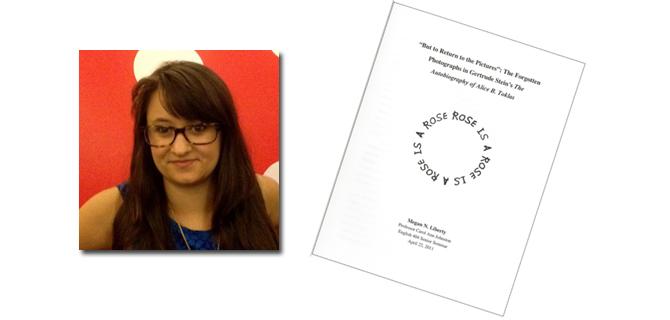
"It wasn’t until I graduated and began discussing my college experience with my colleagues that I realized how unique and rare this level of undergraduate research and writing is. One of the things I liked most about the way 404 works is the freedom each student is given to find a topic he or she is passionate about and develop his or her own research methodology."
Excerpt from Liberty's thesis, "'But to Return to Pictures': The Forgotten Photographs in Gertrude Stein's The Autobiography of Alice B. Toklas"
"The Autobiography of Alice B. Toklas is Gertrude Stein's mock autobiography of her partner Alice, ends with the narrative voice (Alice's voice) retelling a conversation with Stein. The narrative states, 'About six weeks ago Gertrude Stein said, it does not look to me as if you were going to write that autobiography.' Alice1 explains that Stein said, 'You know what I am going to do. I am going to write it for you. I am going to write as simply as Defoe did the autobiography of Robinson Crusoe. And she has and this is it' (Autobiography 310). The final exclamation, 'And she has and this is it' reveals that the text that the reader has just completed is not the autobiography of Alice, but instead a mock-autobiography written by Gertrude Stein herself. This clever final unveiling is coupled with a black-and-white photograph next to it titled 'First page of manuscript of this book' (311). As the title suggests, the photo is a close-up of part of the first handwritten page of the very novel the reader has now completed, beginning 'I was born in San Francisco, California.' Thus these two final assertions contradict each other, the textual narrative claiming Stein as the true author, and the visual image hearkening back to the beginning of the novel, which claims Alice as creator of this autobiography.
The photo also further complicates the earlier claim that "this is it" as it is unclear whether 'this' refers to the written narrative and thus the physical book that the reader holds, or to the adjacent photo of the first page of the handwritten text. This problem of referentiality and the two opposing final claims summarize the many questions Stein raises throughout the Autobiography. Through the coupling of a visual (photographic) and verbal (textual narrative) Stein questions how these two media of representation interact to create a cohesive narrative. She raises the issue of whether one medium is privileged over another. In this case, is the textual narrative more trustworthy than the photo of the text? Should either be trusted? Stein also draws attention to the chain of representation present in all representative media by including a photo of a text, one removed from the handwritten text itself. In this paper I will address the problems of referentiality and media of representation that Stein raises in the Autobiography through the sixteen black-and white photos placed throughout the book.
"1 When discussing the representation of Alice B. Toklas and Gertrude Stein in the narrative, i.e. the characters, I will refer to them by their first names. ("Alice" for the character and "Toklas" for the actual person; likewise "Gertrude" for the character and "Stein" for the actual person.) Also, for the purposes of discussing the narrative, I will refer to "Alice" as the narrator."
What She's Doing Now
Liberty is currently pursuing a graduate degree in Art and Art History at the Courtauld Institute of Art in London.